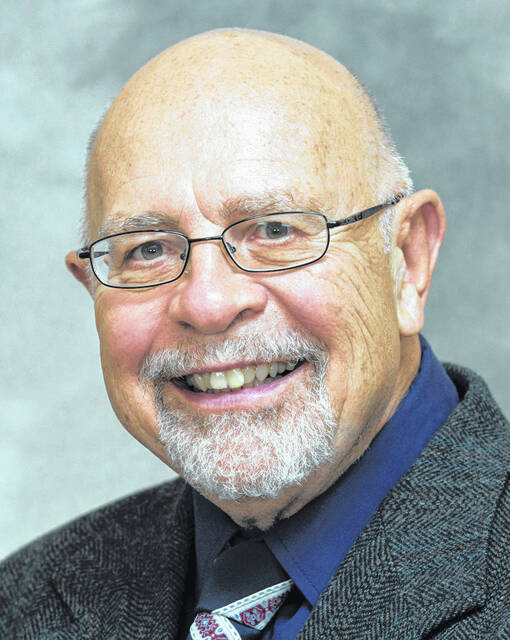
Near Darke
By Hank Nuwer
On the hunt for column material, I scoured the pages of the defunct Union City Times-Gazette. One of its occasional contributing writers was Philip Kabel of Randolph County.
Kabel, born Feb. 1, 1879, became the first president of Randolph County Historical Society in 1922.
He was a participant in local history in 1930 as the Great Depression sank U.S. banks.
On Dec. 8, 1930, as president of the Farmers and Merchants Bank of Randolph County, Kabel closed the bank. He turned the keys over to the Indiana banking department to reorganize.
“The deposits of the Farmers and Merchants bank have decreased more than $100,000 in the last 60 days,” he stated.
Kabel next worked for the welfare department.
He was a supporter of local Boy Scouts. He invited troops to examine a collection of Native American artifacts and curiosities such as a mastodon tooth.
One story he penned for the Union City paper addressed the hideous 1824 murders of peaceful Native Americans. Thieving white settlers conducted a massacre on Fall Creek hunting grounds in newly formed Madison County.
Kabel’s research was based on an account written by U.S. Senator Oliver Hampton Smith.
[Author Disclosure: I went digging into 1824 newspaper accounts and corrected errors in Smith and Kabel’s versions.]
Here is the tale. One day, a party of Native American trappers formed a camp after a successful hunt. The party consisted of three men, four women, and three young children.
They were after raccoons leaving homes in tree holes in pursuit of frogs emerging from the creek’s mud floor. They possessed a pile of furs.
Seven white men approached the party. They were Thomas Harper, James Hudson, Andrew Sawyer, and his brother, John Townsend Bridge, Sr., plus Sawyer’s nephew, John Bridge, Jr., 18. The young son of Sawyer, Stephen Sawyer, and an Andrew Jones were present but did not participate.
The intruders asked the native men to help them find horses they claimed had bolted. It was a ruse.
Harper followed one native. Hudson marched behind the second. Both fired their weapons almost simultaneously. Two victims fell dead.
One adult native male escaped. He reported the crime.
Hearing the shots, Andrew Sawyer trained his gun on one female and squeezed the trigger. Then Bridge Senior and Bridge Junior murdered the remaining three terrified women.
The children started to scatter. Sawyer shot and wounded one boy with a rifle ball. The shooters then killed the other two children. The massacre concluded as Sawyer, in a frenzy, picked up the living boy and whacked him against a fallen log.
They divided the plunder. Harper escaped, perhaps east to Ohio judging from homestead and census records. Native Americans demanded justice.
Authorities found Hudson, Sawyer, and the two Bridges. A blacksmith named Adam Winchell and Sheriff Samuel Cory cuffed them in irons and jailed them.
Indian agent John Johnson of Piqua came to Indiana. He feared an uprising. He tried to appease outraged natives with assurances that the killers would pay for their heinous deeds.
Locals in Pendleton, Ind., constructed a two-room cabin to serve as courthouse.
Three judges were appointed, including Winchell, William W. Wick, and Samuel Holiday. Prosecutors were also appointed.
Numerous attorneys from around the state showed up with offers to represent the defendants. “Only a lawyer would defend a murderer,” said Winchell.
The most dramatic moment in the trials occurred when a prosecutor held up the bloody calico shirt of the native boy who had been brained against a log.
The judges wasted no time, ordering the hanging of the four.
Many members of the victims’ tribe attended the executions.
Hudson was considered a ringleader and died by hanging in 1824.
Sawyer and the elder Bridge died at the gallows in 1825.
The younger Bridge was made to watch his father hang. He sat on his own coffin.
Then the sheriff marched him to the gallows. The condemned youth went to pieces, according to Smith and Kabel. At that moment, either Gov. James Brown Ray or his messenger arrived with a letter of pardon.
Kabel’s tale ended with a quote from Oliver Smith: “Such was the result of the first case on record in America where a white man died for killing an Indian.”
Kurt Vonnegut used that quote in his novel “Sirens of Titan.” However, Vonnegut mistakenly wrote that the massacre happened in Indianapolis.
Historian Kabel died of heart failure on June 23, 1986.
Thomas Harper escaped the hangman.
Young Bridge moved to Delphi, Ind., and married Rosanna Carr. They had one son. Bridge kept out of trouble and died, his neck unstretched, in 1876.
Six years after the massacre, President Andrew Jackson signed the Indian Removal Act. Many died on that Trail of Death.
Hank Nuwer is an author, columnist and playwright. He and wife Gosia live on the Indiana side of the Union City state line. Viewpoints expressed in the article are the work of the author. The Daily Advocate does not endorse these viewpoints or the independent activities of the author.




